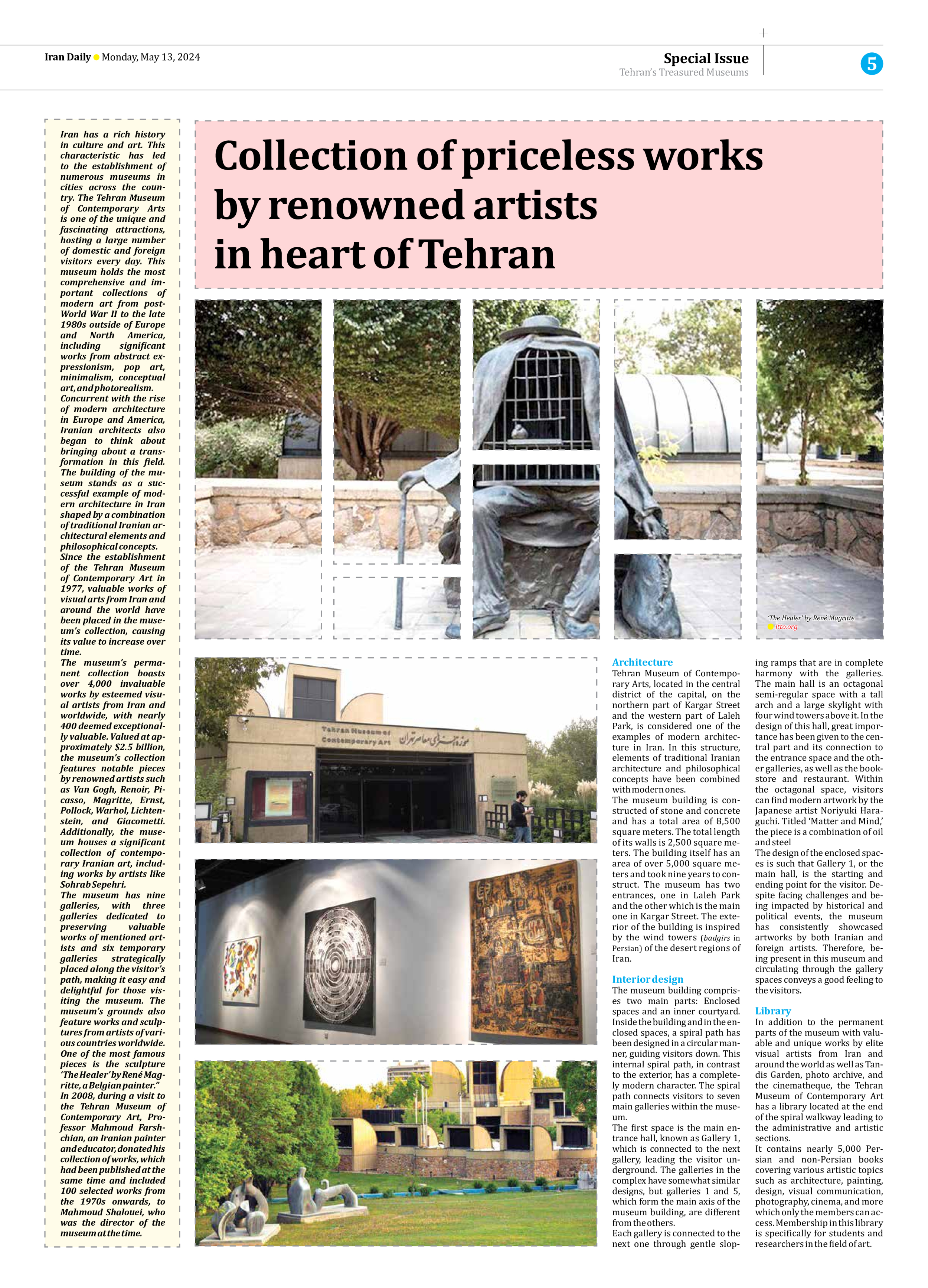
Collection of priceless works by renowned artists in heart of Tehran
Iran has a rich history in culture and art. This characteristic has led to the establishment of numerous museums in cities across the country. The Tehran Museum of Contemporary Arts is one of the unique and fascinating attractions, hosting a large number of domestic and foreign visitors every day. This museum holds the most comprehensive and important collections of modern art from post-World War II to the late 1980s outside of Europe and North America, including significant works from abstract expressionism, pop art, minimalism, conceptual art, and photorealism. Concurrent with the rise of modern architecture in Europe and America, Iranian architects also began to think about bringing about a transformation in this field. The building of the museum stands as a successful example of modern architecture in Iran shaped by a combination of traditional Iranian architectural elements and philosophical concepts. Since the establishment of the Tehran Museum of Contemporary Art in 1977, valuable works of visual arts from Iran and around the world have been placed in the museum’s collection, causing its value to increase over time. The museum’s permanent collection boasts over 4,000 invaluable works by esteemed visual artists from Iran and worldwide, with nearly 400 deemed exceptionally valuable. Valued at approximately $2.5 billion, the museum’s collection features notable pieces by renowned artists such as Van Gogh, Renoir, Picasso, Magritte, Ernst, Pollock, Warhol, Lichtenstein, and Giacometti. Additionally, the museum houses a significant collection of contemporary Iranian art, including works by artists like Sohrab Sepehri. The museum has nine galleries, with three galleries dedicated to preserving valuable works of mentioned artists and six temporary galleries strategically placed along the visitor’s path, making it easy and delightful for those visiting the museum. The museum’s grounds also feature works and sculptures from artists of various countries worldwide. One of the most famous pieces is the sculpture ‘The Healer’ by René Magritte, a Belgian painter.” In 2008, during a visit to the Tehran Museum of Contemporary Art, Professor Mahmoud Farshchian, an Iranian painter and educator, donated his collection of works, which had been published at the same time and included 100 selected works from the 1970s onwards, to Mahmoud Shalouei, who was the director of the museum at the time.
Architecture
Tehran Museum of Contemporary Arts, located in the central district of the capital, on the northern part of Kargar Street and the western part of Laleh Park, is considered one of the examples of modern architecture in Iran. In this structure, elements of traditional Iranian architecture and philosophical concepts have been combined with modern ones.
The museum building is constructed of stone and concrete and has a total area of 8,500 square meters. The total length of its walls is 2,500 square meters. The building itself has an area of over 5,000 square meters and took nine years to construct. The museum has two entrances, one in Laleh Park and the other which is the main one in Kargar Street. The exterior of the building is inspired by the wind towers (badgirs in Persian) of the desert regions of Iran.
Interior design
The museum building comprises two main parts: Enclosed spaces and an inner courtyard. Inside the building and in the enclosed spaces, a spiral path has been designed in a circular manner, guiding visitors down. This internal spiral path, in contrast to the exterior, has a completely modern character. The spiral path connects visitors to seven main galleries within the museum.
The first space is the main entrance hall, known as Gallery 1, which is connected to the next gallery, leading the visitor underground. The galleries in the complex have somewhat similar designs, but galleries 1 and 5, which form the main axis of the museum building, are different from the others.
Each gallery is connected to the next one through gentle sloping ramps that are in complete harmony with the galleries. The main hall is an octagonal semi-regular space with a tall arch and a large skylight with four wind towers above it. In the design of this hall, great importance has been given to the central part and its connection to the entrance space and the other galleries, as well as the bookstore and restaurant. Within the octagonal space, visitors can find modern artwork by the Japanese artist Noriyuki Haraguchi. Titled ‘Matter and Mind,’ the piece is a combination of oil and steel
The design of the enclosed spaces is such that Gallery 1, or the main hall, is the starting and ending point for the visitor. Despite facing challenges and being impacted by historical and political events, the museum has consistently showcased artworks by both Iranian and foreign artists. Therefore, being present in this museum and circulating through the gallery spaces conveys a good feeling to the visitors.
Library
In addition to the permanent parts of the museum with valuable and unique works by elite visual artists from Iran and around the world as well as Tandis Garden, photo archive, and the cinematheque, the Tehran Museum of Contemporary Art has a library located at the end of the spiral walkway leading to the administrative and artistic sections.
It contains nearly 5,000 Persian and non-Persian books covering various artistic topics such as architecture, painting, design, visual communication, photography, cinema, and more which only the members can access. Membership in this library is specifically for students and researchers in the field of art.







